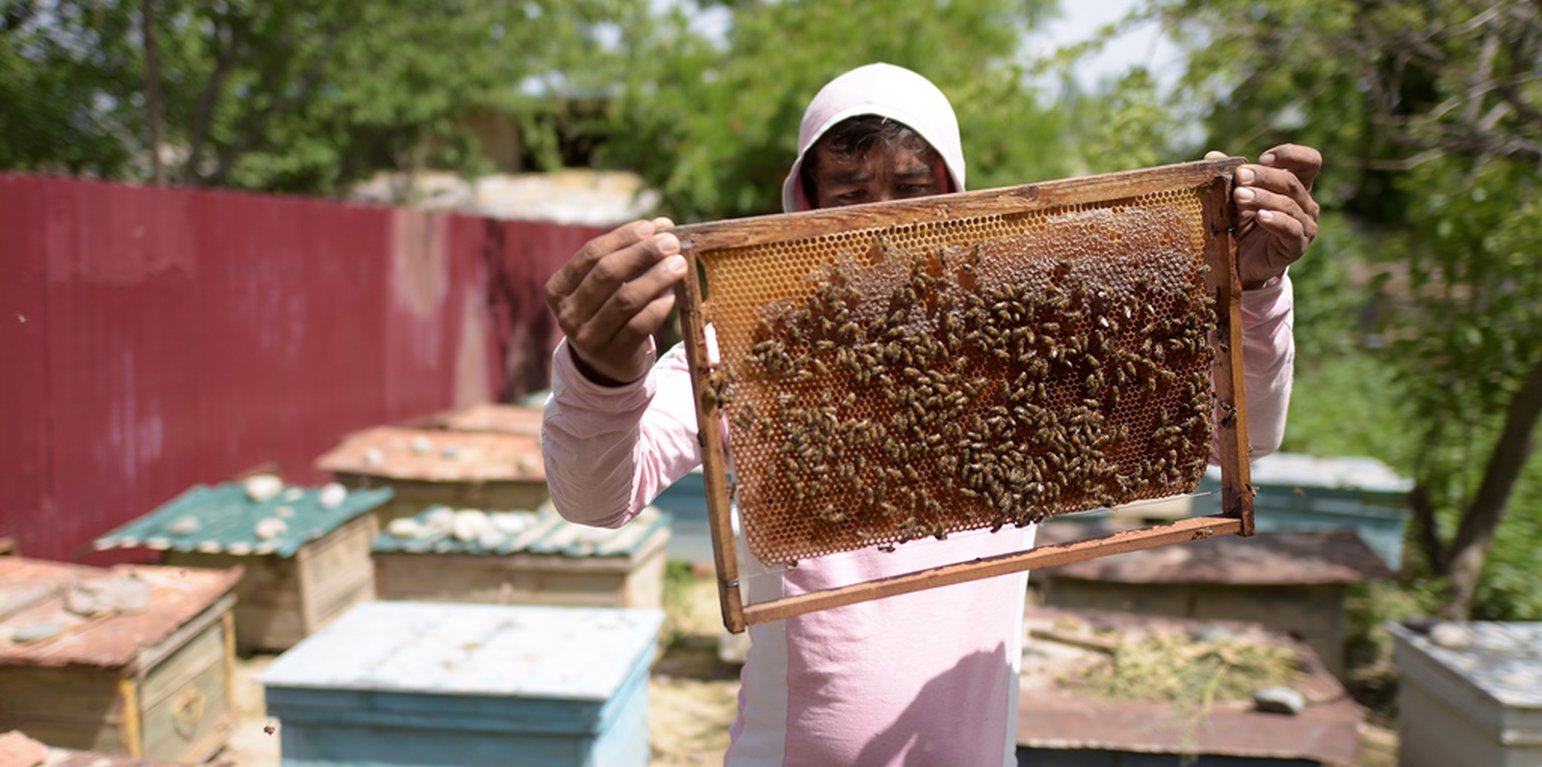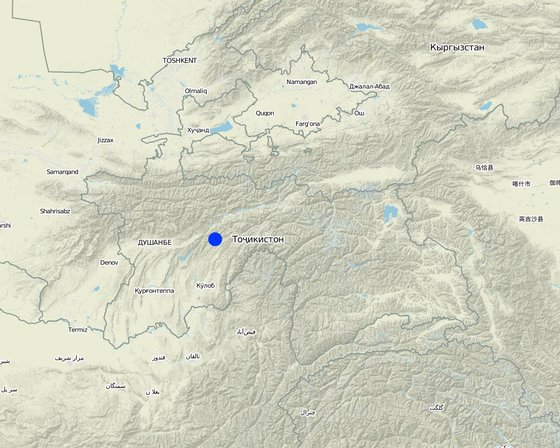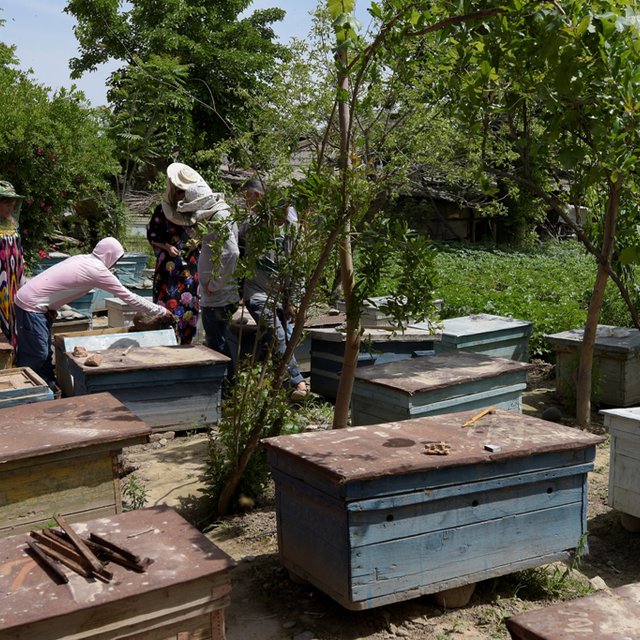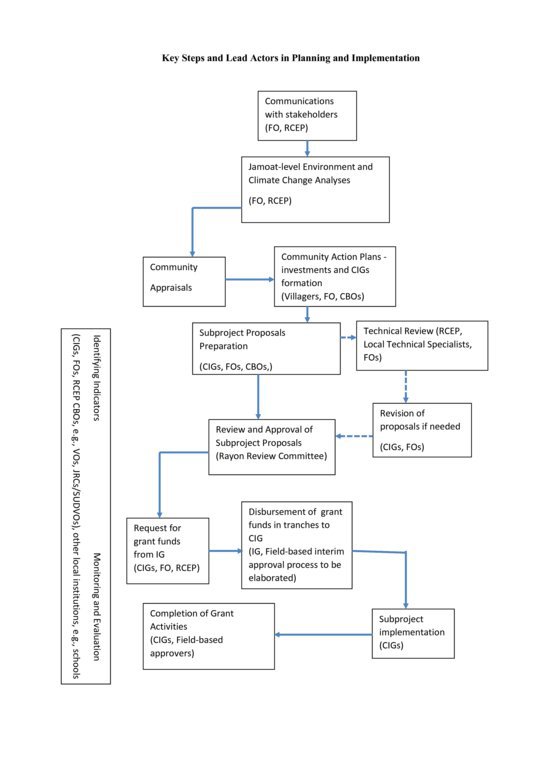



Beekeeping provides an opportunity to improve the economic use and ecosystem sanitation in the future. On the one hand, honeybee keeping improves pollination of trees, shrubs and crops, which will increase the productivity of orchards, arable lands, grassland and highland areas also households got high-quality honey and income. In addition, an approach is supporting households using the existing natural features, population improved their living standards by increasing the production of environmentally sound and high-quality honey, then sold at local markets.
Shaidon village has 238 households and 1651 people are living. Shaidon village is located at a distance of 35 km from the district center. According to statistics, the area of land used in the village is 886 hectares. Of these, 60 hectares are household plots, 26 hectares are private farms and 800 hectares occupy pastures. The population is engaged in breeding 470 heads of neat cattle, 520 heads of small cattle, 5 horses, 120 donkeys, 460 chickens and 60 turkeys. On average, each household has 0.08 ha of plots. The soil in the village is included in the category of gray soil. The annual rainfall in the village is up to 700 mm. Winter lasts for 3 months. The terrain is flat, the source of drinking water is groundwater and natural water resources.
An approach supported on behalf of the ELMARL Project. Shaidon village has expanded and favorable opportunities for the development of the beekeeping sector. and bee families were provided to 25 households that are the CIG members. And the CIG members considers that it necessary to strengthen the productivity of fruit trees in the village, through the development of beekeeping sector, as the result provided bee colonies (hives), appropriate uniforms and supplies, wax and medicines, so that ensure the production of ecologically pure honey, the appearance of additional income and new working places. Farmers have purchased the following units under the Project: 25 hives, 25 bee colonies, 1 pc. smothe king device, 1 pc. special device for collecting honey, 15 pcs. protective clothing, 150 kg of sugar and medicines the purchase of which as well transportation of hives and bee families from Khatlon region were funded by the Project. Arrangement, moving and care of bees is assigned to the farmers.

สถานที่: Sari Khosor jamoat, Shaidon village, Kulob Region, Baljuvon District, ทาจิกิสถาน
วันที่ริเริ่ม: 2016
ปีที่สิ้นสุด: 2017
ประเภทของแนวทาง
| ผู้มีส่วนได้เสียหรือองค์กรที่นำไปปฏิบัติใช้มีส่วนเกี่ยวข้องกับแนวทางนี้อย่างไร | ระบุผู้มีส่วนได้ส่วนเสีย | อธิบายบทบาทของผู้มีส่วนได้ส่วนเสีย |
| ผู้ใช้ที่ดินระดับท้องถิ่นหรือชุมชนระดับท้องถิ่น | CIG members (local farmers) | Local farmers prioritized investments based on a fixed budget for each type of rural investment determined by the number of households. Within a plan of action, participants decided on the allocation of investments to groups of households using rules that limit the funding for any one household. All activities, including PRA, training and investment subprojects involved men and women with due a diligence. Social safety was assured for the people with disabilities, who participated in rural livelihoods activities and had equal rights and voices. |
| ผู้เชี่ยวชาญ SLM หรือที่ปรึกษาการเกษตร | Facilitating organizations and academy of science | Representatives from the facilitating organizations and professors (as TOT trainers) from the Institutions and academies involved during the training |
| รัฐบาลระดับท้องถิ่น | Jamoat representative, Hukumat of the district departments | Jamoat representatives were involved in Participatory Rural Appraisal (PRA) that was used as the main pre-assessment mechanism to analyze the socio-economic and environmental situation in the selected pilots, The RRC(Rayon Review Committee) will consider the combination of proposed sub-projects within the overall context of the rayon and project. The committee will review and accept proposals that meet project guidelines and provide clearance to the Project Staff for the release of project funding to the accounts of relevant CIGs. |
Here is the key steps and actors in the planning and implementation of rural investments. Not all possible participants in these steps are included since local situations may vary and will need to be taken into account during planning and implementation.

การตัดสินใจถูกทำโดย
การตัดสินใจถูกตัดสินอยู่บนพื้นฐานของ
Grant allocation mechanisms. Fund flow arrangements, management and technical, SLM training
Study tours, competition farmer to farmer
During the project implementation training and meetings were organized with the CIG (local people) that will give them the opportunity to manage and maintain on hand approach
All the trainings (composting, mulching, managing salinization, intercropping on slopes, drip irrigation, low-cost watering techniques, solar greenhouses, drought-resistant crops, bee-keeping, mixed fruit orchards, local varieties nurseries, rotational grazing, Livestock breeding and maintaining, strategic watering points, use of perennial forage) that have provided during the project implementation linked somehow to the SLM. And CIG members trying all their best to increase the number of the beehives and expand approach among other villagers
Because before starting of the project "participatory rural appraisal" within ELMARL project was the first steps to the sustainability because the villagers identify and prioritize development needs. This meaning that from the beginning villagers involved and even by them made grant allocation decisions, also CIGs managed grant funds and bought inputs.. Maintaining actions are in place